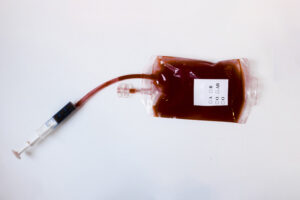Alpha-gal syndrome (AGS), first described in 2009, is associated with a tick bite in which exposed individuals develop IgE antibodies against the alpha-gal oligosaccharide expressed on most mammalian cells and may develop allergies to meat. The alpha-gal antigen is very similar to the RBC Group B antigen, and antibodies may cross react. Two recent case reports describe five Group O transfusion recipients who experienced severe allergic transfusion reactions after receiving Group B plasma (n=4) or platelets (n=1), one of whom died. Transfusion experts from the Biomedical Excellence for Safer Transfusion (BEST) Collaborative suggest that these transfusion reactions may be a new type of clinical transfusion reaction named transfusion-related alpha-gal syndrome (TRAGS). To assess the frequency of Group B and AB plasma and platelet transfusions to Group O recipients and potential TRAGS cases, BEST researchers retrospectively quantified the number of platelet and plasma units transfused during a recent two-year period at 14 sites across 10 countries. Of the 465 to 46,863 plasma units transfused at each site, Group O recipients received Group AB plasma on average 9.9% of transfusions (range, 2.8%- 29.2%) and Group B plasma 3.2% of transfusions (range, 0-12.8%), and plasma wastage would have increased 19.7% if all of the Group B and AB plasma was not transfused. Of the 558 to 74,339 units of platelet units transfused per site, Group O recipients received Group B platelets on average 4.1% (range, 0-14%) and Group AB platelets on average 1.5% of transfusions (range, 0-6%), and platelet wastage would have increased by 9.4% if these units were not transfused. Transfusion services should be aware of the possibility of TRAGS whenever a Group O patient experiences a severe transfusion reaction after exposure to either Group B or AB plasma and platelets.
Reference:

